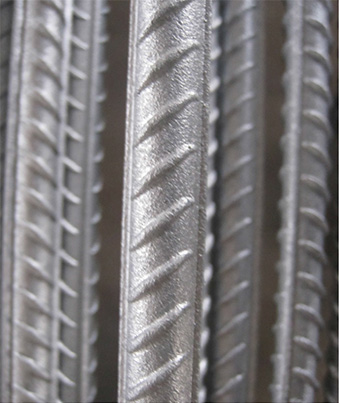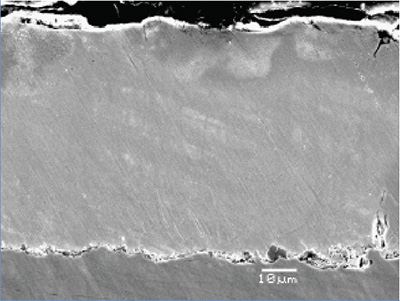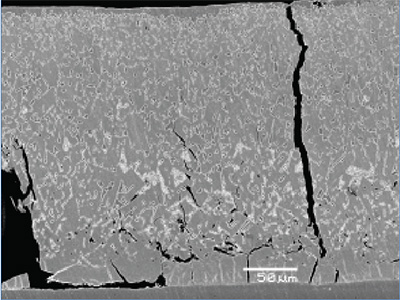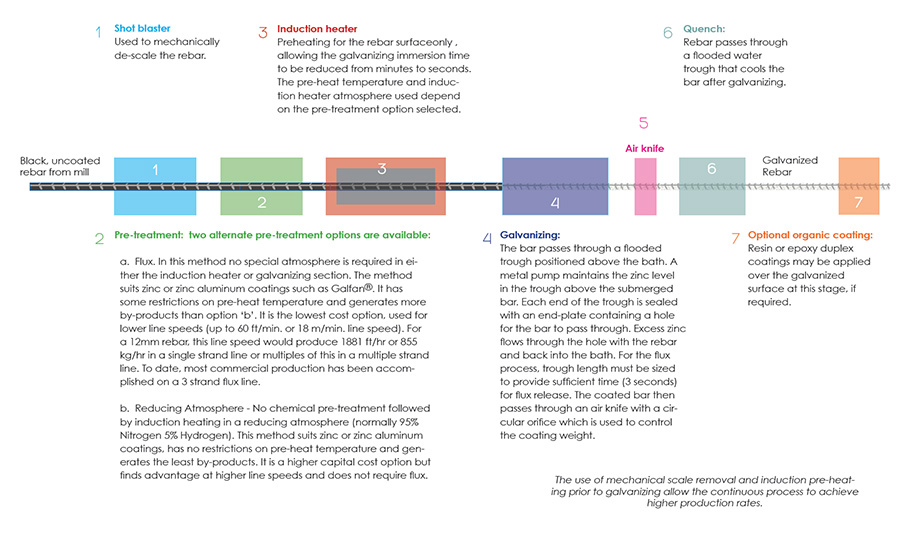Introduction
Galvanizing has been used for more than 100 years because it provides both barrier and galvanic corrosion protection to steel Hot-dip galvanized corrosion-resistant rebar has been used for more than 50 years to protect structures exposed to marine and deicing salt environments from deterioration. A new production process and product, continuously galvanized (CGR) now provides significant cost savings compared to other corrosion resistant rebar systems together with the advantage of on-site formability of the finished product.
The CGR process produces a galvanized rebar with a zinc coating to which a small amount of aluminum is added. The CGR coating provides the well-known corrosion protection of zinc, but also has exceptional formability. The CGR coating passivates faster and corrodes at a slower rate than conventional batch hot dip galvanized coatings, so that a thinner CGR coating can provide equivalent corrosion protection to a heavier batch hot dip coating. The CGR coating has a standard specification of only 50um. The faster continuous processing and more uniform, reduced coating mass lead to reduced production costs for CGR.
The CGR bar can be used directly in concrete to effectively protect the reinforcing steel from corrosion. However, the CGR can also be epoxy coated to produce a duplex coating which provides additional properties to the rebar. For example, the duplex coated bar, trademarked ‘BlueBar’ is being used to protect rebar from stray currents in electrified railway applications. Properly constructed reinforced concrete utilizing galvanized rebar has the potential of providing a service life of 100 years or more.
Metallographic Cross Section of Galvanized Coating’s
How it Works
By using a small amount of Al (0.2%) in the zinc bath, the CGR coating process produces a coating that is almost pure zinc except for an approximately 0.1 micron ternary intermetallic alloy layer (Fe2Al5-xZnx) at the zinc/steel interface. Such a coating, because of its very thin alloy layer (the same as that produced on continuously galvanized sheet products), adheres very well and can be bent or stretched without cracking, and no peeling or flaking.
Further, the CGR process coats the steel with minimum exposure time to the molten zinc before cooling. Including the preheating stage, the total time the steel is at the temperature of the molten zinc (465 °C) is 4-5 seconds. This allows all grades of steel (normal and high strength) to be galvanized with no risk of embrittlement. In fact, any cold work stresses imparted to the bar by a straightening process prior to entry into the coating section are almost entirely relieved by the preheating prior to zinc bath entry. All grades of steel, including high strength steels, will have the same coating of essentially pure zinc.
The Continuous Galvanizing Process for Rebar
Formability
The CGR process results in a flexible and adherant galvanized coating with no thick zinc-iron alloy layers. The coated bar can be bent, stretched, twisted or otherwise fabricated after the galvanizing process is complete without cracking or flaking the coating, regardless of the total coating mass. As a result, there is no zinc loss due to brittleness during forming in the field and repair requirements are minimal.
Fabricating CGR after galvanizing reduces transportation, manufacturing, and fabrication costs. The costs of installation and placement by accommodating last minute job site modifications and revisions are also reduced. This saves valuable time and money.
Why Choose Continuous Galvanized Rebar (CGR)?
Superior Coating Adhesion
- The CGR process produces a coating that is almost pure zinc except for approximately 0.1 micron of intermetallic alloy layer (Fe2Al5-xZnx) at the zinc/steel interface
a. A small amount of Al (0.2%) is added to the zinc bath.
b. The resulting thin alloy layer that is the same as produced on continuously galvanized sheet and is very adherent and formable. - The thin alloy layer remains the same thickness for all masses of zinc over it and is not affected by the grade of steel substrate, i.e., reactive steels are not an issue with obtaining good adhesion.
- With no thick zinc-iron alloy layers, the coated bar can be bent, stretched, or twisted without cracking or flaking the coating, regardless of the total coating mass.
- There is no zinc loss due to brittleness during forming in the field and repair requirements are minimal.
Superior Corrosion Resistance in Concrete
- The zinc passivation stage during concrete curing normally consumes about 1 micron of zinc but with CGR coatings there is always pure zinc under the passivation layer so the passivation stage could not consume all the pure zinc.
- Pure zinc reacts best with wet concrete to form an effective CaHZn passivation layer.
- CGR requires less zinc without compromising corrosion protection.
Ease of Coating
- The CGR coating process is flexible – as few as one or as many as 8 bars can be run at a time. It is also possible to convert coiled black rebar into coiled CGR.
- Even at a lower production rate, a line can run continuously for longer times (with minimal manpower) to produce the amount needed.
- Processing line can easily be started on demand and shut down very quickly – the zinc reservoir is relatively small, easily heated and temperature controlled.
Cost
- The cost of CGR is less than 20% above the cost of black rebar.
Standards
The CGR product can be ordered internationally under ISO specification 14657 ‘Zinc coated steel for the reinforcement of concrete.’ ISO 14657 specifies three classes, Class A, Class B and Class C coatings, that differ by coating mass.
CGR is also covered byASTM specification A1094/A1094M ‘Specification for continuous hot-dip galvanized steel bars for concrete reinforcement.’ This standard specification covers steel reinforcing bars with protective zinc or zinc-alloy coatings applied by the continuous hot-dip process. One coating class of 360g/m3 is specified.
Within China there is an effort to establish a domestic national standard for CGR and an application has been submitted to the National Standardization Administration.
In India, a standard exists for hot-dip zinc coatings on Structural Steel Bars for Concrete Reinforcements (IS:12594: 2008).The requirement of mass of zinc coating is similar to the ISO 14657 product standard. There are no Indian standards specific to CGR as yet, and efforts are being made for a unique IS standard for commercial production of CGR in India.






